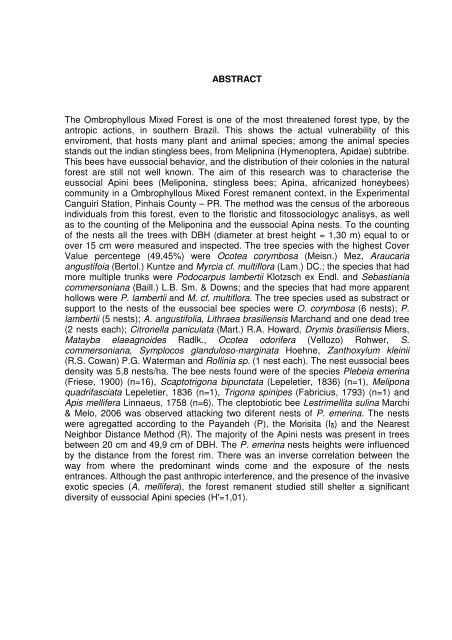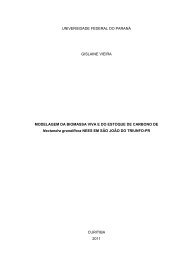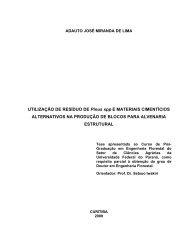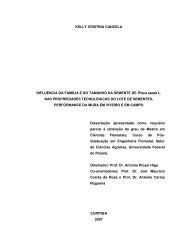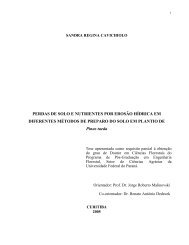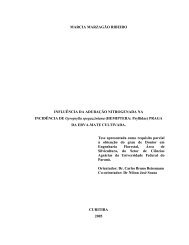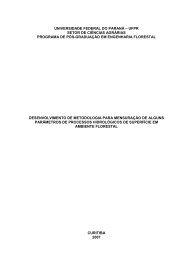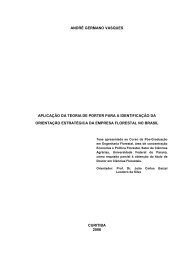daros augusto teodoro da silva caracterização da distribuição e ...
daros augusto teodoro da silva caracterização da distribuição e ...
daros augusto teodoro da silva caracterização da distribuição e ...
Create successful ePaper yourself
Turn your PDF publications into a flip-book with our unique Google optimized e-Paper software.
ABSTRACT<br />
The Ombrophyllous Mixed Forest is one of the most threatened forest type, by the<br />
antropic actions, in southern Brazil. This shows the actual vulnerability of this<br />
enviroment, that hosts many plant and animal species; among the animal species<br />
stands out the indian stingless bees, from Melipnina (Hymenoptera, Api<strong>da</strong>e) subtribe.<br />
This bees have eussocial behavior, and the distribution of their colonies in the natural<br />
forest are still not well known. The aim of this research was to characterise the<br />
eussocial Apini bees (Meliponina, stingless bees; Apina, africanized honeybees)<br />
community in a Ombrophyllous Mixed Forest remanent context, in the Experimental<br />
Canguiri Station, Pinhais County – PR. The method was the census of the arboreous<br />
individuals from this forest, even to the floristic and fitossociologyc analisys, as well<br />
as to the counting of the Meliponina and the eussocial Apina nests. To the counting<br />
of the nests all the trees with DBH (diameter at brest height = 1,30 m) equal to or<br />
over 15 cm were measured and inspected. The tree species with the highest Cover<br />
Value percentege (49,45%) were Ocotea corymbosa (Meisn.) Mez, Araucaria<br />
angustifoia (Bertol.) Kuntze and Myrcia cf. multiflora (Lam.) DC.; the species that had<br />
more multiple trunks were Podocarpus lambertii Klotzsch ex Endl. and Sebastiania<br />
commersoniana (Baill.) L.B. Sm. & Downs; and the species that had more apparent<br />
hollows were P. lambertii and M. cf. multiflora. The tree species used as substract or<br />
support to the nests of the eussocial bee species were O. corymbosa (6 nests); P.<br />
lambertii (5 nests); A. angustifolia, Lithraea brasiliensis Marchand and one dead tree<br />
(2 nests each); Citronella paniculata (Mart.) R.A. Howard, Drymis brasiliensis Miers,<br />
Matayba elaeagnoides Radlk., Ocotea odorifera (Vellozo) Rohwer, S.<br />
commersoniana, Symplocos glanduloso-marginata Hoehne, Zanthoxylum kleinii<br />
(R.S. Cowan) P.G. Waterman and Rollinia sp. (1 nest each). The nest eussocial bees<br />
density was 5,8 nests/ha. The bee nests found were of the species Plebeia emerina<br />
(Friese, 1900) (n=16), Scaptotrigona bipunctata (Lepeletier, 1836) (n=1), Melipona<br />
quadrifasciata Lepeletier, 1836 (n=1), Trigona spinipes (Fabricius, 1793) (n=1) and<br />
Apis mellifera Linnaeus, 1758 (n=6). The cleptobiotic bee Lestrimellita sulina Marchi<br />
& Melo, 2006 was observed attacking two diferent nests of P. emerina. The nests<br />
were agregatted according to the Payandeh (P), the Morisita (I) and the Nearest<br />
Neighbor Distance Method (R). The majority of the Apini nests was present in trees<br />
between 20 cm and 49,9 cm of DBH. The P. emerina nests heights were influenced<br />
by the distance from the forest rim. There was an inverse correlation between the<br />
way from where the predominant winds come and the exposure of the nests<br />
entrances. Although the past anthropic interference, and the presence of the invasive<br />
exotic species (A. mellifera), the forest remanent studied still shelter a significant<br />
diversity of eussocial Apini species (H'=1,01).


